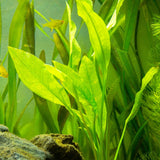Hottonia Palustris Aquatic Pond Plant - Water Violet
Hottonia palustris, commonly known as Water Violet or Featherfoil, is a delicate aquatic plant belonging to the Primulaceae family. It is native to Europe and Asia and is commonly found in shallow, still or slow-moving freshwater habitats, such as ponds, lakes, and marshes.
Here is a detailed description and care guide for Hottonia palustris:
Description:
Hottonia palustris is a perennial plant with submerged or floating leaves and stems. It typically grows to a height of 15-30 cm (6-12 inches), with the stems rising above the water's surface.
The leaves are finely divided and feathery, arranged in whorls around the stem. The submerged leaves are bright green and delicate, while the emergent leaves are larger and broader. The plant produces small, five-petaled white or pale pink flowers that emerge on slender stalks above the water.
Care Guide:
Water Requirements: Hottonia palustris requires clean, freshwater conditions with a pH range of 6.5-7.5. The water should be still or have gentle water movement, as strong currents can damage the delicate leaves and stems. Maintain a water depth that allows the plant's emergent leaves and flowers to grow above the water surface.
Lighting: Provide moderate to bright light for Hottonia palustris. If growing indoors, place the plant near a window with filtered sunlight or use full-spectrum grow lights.
Water Temperature: Hottonia palustris prefers cool to moderate water temperatures ranging from 10-24°C (50-75°F). Avoid exposing the plant to extreme temperature fluctuations.
Substrate: Use a fine-grained, nutrient-rich substrate to anchor the plant's roots. The substrate should be well-draining but capable of retaining moisture. Adding a layer of aquatic plant fertilizer or clay-based substrate can provide additional nutrients for optimal growth.
Fertilization: Hottonia palustris benefits from regular fertilization with a balanced aquatic plant fertilizer. Follow the manufacturer's instructions for dosage and frequency, as excessive fertilization can lead to algae growth.
CO2 and Nutrient Supplementation: Providing a carbon dioxide (CO2) supplement and adding micronutrients can promote healthy growth and vibrant leaf coloration.
Pruning and Maintenance: Remove any dead or decaying leaves or stems to maintain the plant's appearance and prevent debris buildup. Regularly thin out the plant to prevent overcrowding and allow for adequate light penetration.
Propagation: Hottonia palustris can be propagated through both division and stem cuttings. To divide the plant, carefully separate the rooted portions and replant them in suitable substrate. Stem cuttings can be taken and placed in a separate container with suitable conditions until they develop roots.
Pests and Diseases: Hottonia palustris is generally resistant to pests and diseases. However, it is important to maintain good water quality and monitor for any signs of disease or pest infestation.
If needed, treat with appropriate aquatic plant-safe treatments following the manufacturer's instructions. Hottonia palustris adds a graceful and delicate touch to freshwater aquariums, ponds, and water gardens. It provides hiding places for small fish and invertebrates, as well as a source of oxygen and filtration. Additionally, it contributes to a natural and balanced aquatic ecosystem. Ensure to check and comply with local regulations regarding the cultivation and control of Hottonia palustris in your region.
Selection of Plants:
Choose appropriate oxygenating plants that are suitable for the size and depth of your pond. Common oxygenating plants include Hornwort (Ceratophyllum), Anacharis (Elodea canadensis), Waterweed (Elodea densa), and Watermilfoil (Myriophyllum species).
Placement:
Place oxygenating plants in the water at a depth where their foliage is fully submerged. Distribute the plants evenly throughout the pond, ensuring they receive adequate sunlight for photosynthesis.
Water Quality:
Oxygenating plants play a crucial role in maintaining good water quality by absorbing excess nutrients, competing with algae for resources, and releasing oxygen through photosynthesis. Regularly monitor water quality parameters such as pH, ammonia, nitrite, and nitrate levels to ensure they are within suitable ranges for the plants.
Nutrient Levels:
Oxygenating plants benefit from moderate nutrient levels in the water, but excessive nutrients can lead to rapid algae growth. Avoid over-fertilization or excessive organic matter accumulation in the pond, as it can negatively impact oxygenating plants.
Pruning and Maintenance:
Regularly thin out and prune oxygenating plants to prevent overcrowding and ensure healthy growth. Remove any dead or decaying plant material promptly to maintain water quality and prevent the release of excess nutrients.
Winter Care:
Some oxygenating plants may need special attention during winter, especially in colder climates. If your pond experiences freezing temperatures, consider moving potted plants indoors or provide insulation to protect them. In milder climates, oxygenating plants may continue to grow during winter, providing oxygen and supporting the pond ecosystem.
Propagation:
Some oxygenating plants can be propagated by dividing or taking cuttings. Follow specific instructions for each plant species to propagate them successfully and maintain a healthy population in your pond.
Monitoring and Control:
Regularly observe the growth and condition of oxygenating plants to identify any signs of disease, pests, or nutrient deficiencies. If needed, control excessive growth by removing excess plant material, but be careful not to remove too much at once, as it can disturb the pond's ecological balance.
Introduction of New Plants:
Before introducing new oxygenating plants into your pond, ensure they are free from pests, diseases, or invasive species. Avoid introducing non-native species that may become invasive and harm the local ecosystem. By following these general tips and care guidelines, you can maintain healthy oxygenating plants in your pond. They will contribute to the overall oxygenation of the water, provide habitat for beneficial organisms, and promote a thriving pond ecosystem.


































